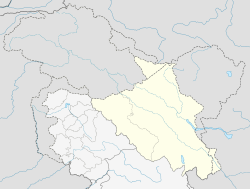| Namgyal Tsemo Monastery | |
|---|---|
 Namgyal Tsemo Monastery | |
| Religion | |
| Affiliation | Tibetan Buddhism |
| Sect | Gelug |
| Location | |
| Location | Leh district, Ladakh, India |
| Country | India |
| Coordinates | 34°10′3″N77°35′24″E / 34.16750°N 77.59000°E |
| Architecture | |
| Founder | Tashi Namgyal |
| Completed | 1430 |
Namgyal Tsemo Monastery or Namgyal Tsemo Gompa is a Buddhist monastery in Leh city of Leh district, Ladakh, northern India. [1] Founded by King Tashi Namgyal (1555-1575) of Ladakh, it has a three-story high gold statue of Maitreya Buddha and ancient manuscripts and frescoes. [1] It is situated near the Tsemo Castle.
Contents
- Namgyal Tsemo Monastery perched over Leh town
- Tsemo Castle
- Prayer flags



